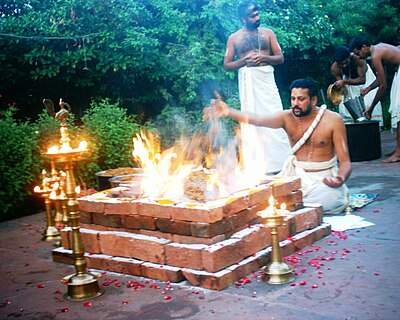Brahmanism
As Brahmanism an early religion of the Indian subcontinent is called, which was based on the Vedic scriptures. It dominated India as a religious practice from around 800 BC. Chr. To 500 BC. Chr. The designation goes to Monier Monier-Williams (1883) back.
Jainism and Buddhism have their roots in Brahmanism. Brahmanism, for its part, was rooted in the Vedic religion , which formed the basis for further religious differentiation in ancient India. Cultic acts in the form of rituals were also of great importance in the Vedic period. The Vedic religion is very different from later Hinduism . The writings of the Vedic religion are preserved in the Vedas , the origins of which are probably from 1500 BC. As an oral tradition. Brahmanism is also considered proto-Hinduism
The teaching of Atman (soul) and Brahman (world soul), which was formulated in the Upanishads , is to be regarded as the philosophical basis of Brahmanism . Atman and Brahman are considered to be of the same essence here, but a person must first spiritually recognize this identity before he can achieve salvation, the moksha . Essential foundations of all Indian religions were laid during this time, such as the idea of samsara , the repetitive cycle of birth and death, and the law of karma .
Doctrine and sacrificial cult
The teaching was formulated by the Brahmins , who provided the priests and scholars in the stratified society , and passed on from teachers to students. The center of Brahmanism is the ' sacrifice ' or sacrificial rituals, they are a highly complex system that was based on a magical understanding and moved correct execution to the center of religious events. The acts of sacrifice had been described in a precise manner down to the smallest action sequences, during the execution of the sacrifice and all the related ceremonies. The plot was pervaded by a 'speculation of sacrifices' that tried to interpret the numerous ceremonies. In addition to the speculation of sacrifices, there was the myth poetry, which gave the explanation for the origin of the most diverse ceremonies through all kinds of stories.
Sacrificial rituals, which formed the focus of religious understanding, originated in the Middle Vedic period, around 1200–850 BC. While in early Vedic times it was the gods such as Agni , Indra and Prajapati , to whom believers turned in prayer or sacrifice, a trained, hereditary caste of priests gradually emerged , which was very soon considered to be indispensable to the gods by means of ritual acts To influence one's own spiritual concerns.
In no way was it certain that the gods would accept a sacrifice. They had to be asked to come, by means of certain mantras and other ritual practices they could be summoned to express the spiritual concern or wish that the believer hoped to be fulfilled. The increasing specialization and elaboration of such sacrificial rituals brought the priests a great deal of power . The knowledge of the necessary practices even raised them, according to their claim, to a position equal to the gods. Their privileged position also created the opportunity to convert these services into a commodity. So the first sacrificial fees (dakṣiṇā ) could be raised, as a result of which the Vedic sacrifice increasingly became an exclusive ritual.
In terms of textual history, the Brahmanas form the starting point, sacrificial and ritual texts that focus on the correct execution of the sacrifice. In individual chapters they contain the Vedic Upanishads , which in many places question the mechanistic sacrificial technique and philosophically overcome it.
In Brahmanism, the Brahmins played a central role as experts in sacrifice and ritual. They were the mediators between men and the gods. Bhakti , the devotion of a believer to his personal God, as it was later practiced especially in Vishnuism , did not yet play a role here. The worship of Hindu gods like Vishnu and Shiva did not develop until later.
With the advent of Buddhism in the 5th century BC In the 2nd century BC the dominant position of the Brahmanas faded into the background and Brahmanism lost its importance. The contents of the great Indian epics, Ramayana , Mahabharata and especially the Bhagavadgita , gained in religious influence and the first signs of the Bhakti movement can be perceived.

literature
- Paul Gäbler : Vedic and Brahmanic Religion In: Evangelisches Kirchenlexikon - Kirchlich-theologisches hand dictionary . Volume P – Z, 1st edition, Vandenhoeck & Ruprecht, Göttingen, 1959, column 1618–1621.
- Monier Monier-Williams : Religious thought and Life in India. Part 1; Vedism, Brahmanism, and Hinduism John Murray, London 1883 ( [3] on digi.ub.uni-heidelberg.de) pp. 20–53.
- Sarvepalli Radhakrishnan: Indian Philosophy. 2, The Systems of Brahmanism. [Translator: Rudolf Jockel] 1956.
Web links
- Thomas Oberlies: The ascetic movement of the late Vedic period and early Buddhism. April 19, 2000, ( PDF on buddhismuskunde.uni-hamburg.de).
- Silke Bechler: The Vedic sacrifice in a new public in India and Europe. Dissertation University Heidelberg, Heidelberg May 8, 2013 ( PDF on archiv.ub.uni-heidelberg.de) here p. 10 f.
Individual evidence
- ^ Monier Monier-Williams : Religious thought and Life in India. Part 1; Vedism, Brahmanism, and Hinduism. John Murray, London 1883 ([1] on digi.ub.uni-heidelberg.de) here p. 20.
- ^ Philip Auslandser (Ed.): Performance: pt. 1. Foundations and definitions. Taylor & Francis, London / New York 2003 ( [1] on books.google.de) p. 58.
- ^ Encyclopaedia Britannica (India): Students' Britannica India. Volume 5. New Delhi 2000. p. 234.
- ↑ Ingrid Fischer-Schreiber (Ed.): The Rider Encyclopaedia of Eastern Philosophy and Religion. Rider & Co, London 1989, ISBN 978-0-71261-192-3 , p. 403.
- ↑ Damen Conversations Lexikon , Volume 2. Leipzig 1834, pp. 161-164 ( [2] ).
- ↑ Axel Michaels : The Hinduism: Past and Present. Beck, Munich 1998, ISBN 978-3-40644-103-5 , pp. 51-54.